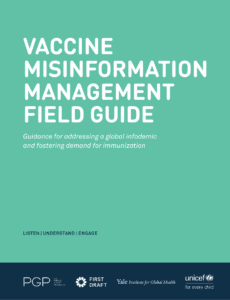Misinformation Alerts
Knowing what misinformation is being shared can help you generate effective messaging.
These insights are based on a combination of automated media monitoring and manual review by public health data analysts. Media data are publicly available data from many sources, such as social media, broadcast television, newspapers and magazines, news websites, online video, blogs, and more. Analysts from the Public Good Projects triangulate this data along with other data from fact checking organizations and investigative sources to provide an accurate, but not exhaustive, list of currently circulating misinformation.
Misinformation Alerts
Knowing what misinformation is being shared can help you generate effective messaging.
These insights are based on a combination of automated media monitoring and manual review by public health data analysts. Media data are publicly available data from many sources, such as social media, broadcast television, newspapers and magazines, news websites, online video, blogs, and more. Analysts from the Public Good Projects triangulate this data along with other data from fact checking organizations and investigative sources to provide an accurate, but not exhaustive, list of currently circulating misinformation.Alerts are categorized as high, medium, and low risk.
- High risk alerts: Narratives with widespread circulation across communities, high engagement, exponential velocity, and a high potential to impact health decisions. Are often more memorable than accurate information.
- Medium risk alerts: Narratives that are circulating in priority populations and pose some threat to health. Potential for further spread due to the tactics used or because of predicted velocity. Often highlights the questions and concerns of people.
- Low risk alerts: Narratives that are limited in reach, don’t impact your community, or lack the qualities necessary for future spread. May indicate information gaps, confusion, or concerns.
A widely circulated video clip shows a former Pfizer executive turned anti-vaccine activist claiming that the pandemic was orchestrated. One post sharing the clip has been viewed over 1.2 million times and has garnered over 64,000 engagements. The former executive has a long history of promoting COVID-19 misinformation, including claiming COVID-19 vaccines were 50 times more likely to kill children than the disease, lending him credibility in the anti-vaccine community.
Recommendation: The individual’s credentials and former position at Pfizer increase the risk of his claims. Debunking messaging may emphasize the source’s lack of credibility and history of promoting conspiracy theories. Messaging may also explain that there is no evidence to support the conspiracy theory that governments, pharmaceutical companies, or other influential stakeholders planned the COVID-19 pandemic. The virus that causes COVID-19 is part of the family of viruses behind multiple major disease outbreaks in the last 20 years. Fact-Checking Source(s): 
A post that has been shared over 11,000 times has resurfaced the misleading claim that insurance programs bribed doctors to administer COVID-19 vaccines. A U.S. congressperson previously circulated the claim.
Recommendation: The persistence of this misinformation and its circulation by high-profile individuals increases its risk. Debunking talking points may emphasize that health insurance companies offer incentive programs to boost patient health outcomes. These companies recognize that vaccinations are an important part of keeping patients healthy by reducing their risk of contracting vaccine-preventable diseases, thereby reducing healthcare costs. Fact Checking Source(s): AP News, USA Today, PolitiFact 
Videos circulating on multiple social media platforms falsely claim that a U.S. Supreme Court ruling classifies people who received mRNA vaccines as “patented goods.” The videos claim that the vaccines altered recipients' DNA such that they are no longer considered humans and can be denied human rights. This false claim has circulated several times since COVID-19 vaccines were rolled out.
Recommendation: The persistence and widespread nature of myths that mRNA vaccines affect genetic material increase their risk. Debunking messaging may explain that the claim in the video is based on a misrepresentation of a 2013 Supreme Court case unrelated to mRNA vaccines or therapies. The case ruled that a company that discovered genetic mutations that increase breast cancer risk could not patent those genes but that synthetic genes made in a lab could be patented. Patients who receive patented medical interventions like pacemakers and insulin pumps do become patented goods as a result. Fact Checking Source(s): USA Today, AP News, Reuters
Several social media and blog posts question if the diphtheria, tetanus, and pertussis (DTaP) vaccine is necessary. The post focuses on pertussis, also called whooping cough, a severe respiratory infection that can cause severe illness and death in infants. One post claims the decline in pertussis deaths is unrelated to the vaccine, while the other falsely claims that the DTaP vaccine contains the mercury-based additive thimerosal.
Recommendation: Myths that vaccines are unsafe because of thimerosal have circulated for decades. Debunking messaging may explain that, although some older vaccines contained small, nontoxic amounts of thimerosal, no childhood vaccine administered since 2001 has contained the substance. Messaging may also emphasize that pertussis is a serious and potentially deadly disease that can be easily prevented through vaccination. Up to 50 percent of babies with pertussis end up in the hospital. Of those, 1 in 5 develop pneumonia, and 1 in 100 die. However, pertussis cases decreased by 75 percent after the vaccine was introduced. Fact Checking Source(s): CDC, CHOP
A social media post claims without evidence the 10-year-old daughter of a Johnson & Johnson executive died suddenly after receiving the COVID-19 vaccine.
Recommendation: Debunking messaging may emphasize how vaccine opponents exploit tragic injuries and deaths to promote their anti-vaccine rhetoric, even over the objection of the victims’ families. As with previous cases, there is no evidence that the girl’s death was in any way related to vaccines or even that she was vaccinated. Her family says that she died from a seizure caused by a brain injury. Fact Checking Source(s): Lead Stories
The CDC shut down an unauthorized lab in Fresno, California, that reportedly contained thousands of gallons of hazardous and infectious agents, including coronavirus, HIV, and bioengineered mice designed to spread COVID-19. The lab that authorities have been investigating for months was registered to several addresses in California and China. Some vaccine opponents have suggested that the lab is part of a larger government conspiracy or that its existence supports the belief that COVID-19 was created in a lab.
Recommendation: Scientists do not know the exact origin of COVID-19, resulting in myths and misconceptions that have persisted since the earliest days of the pandemic. These myths are often a gateway to other COVID-19 and anti-vaccine conspiracy theories. Responding directly to this piece of misinformation may only amplify its reach. But if necessary, messaging may emphasize that the unauthorized lab was investigated and shut down by local and federal authorities and that there is no evidence of any government conspiracy. Fact-checking sources:
The FDA recently approved the anthrax vaccine Cyfendus for adults up to age 65 with suspected or confirmed exposure to Bacillus anthracis, the bacteria that causes anthrax. Several vaccine opponents claim that the approval was “rushed” and misleadingly claim that the vaccine was approved for all people, falsely implying that it will be a routinely administered vaccination.
Recommendation: The criticism demonstrates opposition to any new vaccine among COVID-19 vaccine opponents. Messaging may emphasize that the vaccine is not new, nor was its approval rushed. Cyfendus has been used since 2019 under emergency use authorization as post-exposure anthrax prevention. Fact Checking Source(s): Fierce Pharma, Reuters
A video circulating on social media claims that the lipid nanoparticles that protect vaccine mRNA as it is delivered to cells can interact with and be programmed by 5G wireless technology. The claim is based on a patent filed by Moderna related to lipid nanoparticle delivery of mRNA and other genetic material. The patent has nothing to do with 5G or any other cellular or wireless technology.
Recommendation: Responding to conspiracy theories may detract from priority talking points. Many health organizations have already debunked the conspiracy theory that COVID-19 vaccines have any link to 5G. Fact-checking sources:
Last week, a University of Southern California basketball player and son of an NBA star was admitted to the hospital after going into cardiac arrest during a workout. Shortly after the news broke, vaccine opponents began baselessly claiming that his cardiac arrest was vaccine-related. Speculation about the young athlete having vaccine-induced myocarditis has garnered millions of views and thousands of shares on social media.
Recommendation: Vaccine opponents have a well-established pattern of seizing on high-profile illness and death as alleged evidence of a COVID-19 vaccine injury. These false claims are the conclusion of a consistent, multi-year misinformation campaign. Debunking messaging may explain that there is no evidence that the athlete’s condition is vaccine-related and that this is just the latest example of the well-established trend of vaccine opponents exploiting a high-profile injury or death to spread misinformation about vaccine safety. Messaging may also emphasize that cardiac events, while rare, are the leading cause of sports-related deaths among young athletes. The issue has been a major concern for over a decade, so much so that the NCAA released specific guidance in 2016 to prevent cardiac events in college athletes. Fact-Checking Source(s): 
A discredited research scientist best known for promoting health-related conspiracy theories recently accused Pfizer of “covering up” a batch of the diphtheria, tetanus, and pertussis (DTaP) vaccines linked to sudden infant death syndrome (SIDS) cases. According to the post, instead of simply recalling the batch, the company deliberately distributed it throughout the country to avoid clusters of injury and death and then recorded the plot in a memo. This claim is related to the recently resurfaced myth that the U.S. Supreme Court declared vaccines “unavoidably unsafe.”
Recommendation: Myths about childhood vaccines and SIDS are widespread, increasing the risk of this misinformation. Debunking messaging may emphasize that anti-vaccine groups have attempted for decades to falsely link childhood vaccines to SIDS despite evidence conclusively showing no link between the condition and any vaccine. SIDS occurs at the same rate in vaccinated and unvaccinated children and has not increased with higher vaccination rates. Vaccines are rigorously monitored for safety, and the batches are recalled immediately when contamination is detected. Fact Checking Source(s): AP News, Health Feedback
Alerts are categorized as high, medium, and low risk.
- High risk alerts: Narratives with widespread circulation across communities, high engagement, exponential velocity, and a high potential to impact health decisions. Are often more memorable than accurate information.
- Medium risk alerts: Narratives that are circulating in priority populations and pose some threat to health. Potential for further spread due to the tactics used or because of predicted velocity. Often highlights the questions and concerns of people.
- Low risk alerts: Narratives that are limited in reach, don’t impact your community, or lack the qualities necessary for future spread. May indicate information gaps, confusion, or concerns.
Vaccine Misinformation Guide
Get practical tips for addressing misinformation in this new guide. Click image to download, or see highlights.

